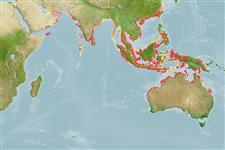Actinopterygii (ray-finned fishes) >
Clupeiformes (Herrings) >
Engraulidae (Anchovies) > Coiliinae
Etymology: Thryssa: Greek, thrissa, -es = shad (Ref. 45335).
Environment / Climate / Range
Ecology
Marine; brackish; pelagic-neritic; amphidromous (Ref. 51243); depth range 10 - 13 m. Tropical, preferred ?; 31°N - 25°S, 52°E - 152°E
Indo-Pacific: Persian Gulf eastward to Myanmar, Andamans and Penang; Taiwan south to Arafura Sea (Ref. 9819), the northern coasts of Australia and Papua New Guinea; Sarawak; a record from the Bonin Islands; presumably the Philippines; perhaps not eastward to the Hebrides, etc.
Size / Weight / Age
Maturity: Lm ? range ? - ? cm
Max length : 27.0 cm SL male/unsexed; (Ref. 30691)
Dorsal
spines
(total): 0;
Anal
spines: 0;
Anal
soft rays: 32 - 39. Belly with 23 to 26 keeled scutes from isthmus to anus. Tip of snout above level of eye center, usually about level of upper rim of eye. Maxilla short or moderate; first supra-maxilla small, oval. A dark blotch behind upper part of gill opening.
Coastal pelagic (Ref. 68964). Presumably schooling, inshore and entering estuaries. More precise data needed, based on correct identifications. If this is the species being referred to in Ref. 6841, then the principal food of the young would be prawns and copepods, supplemented by polychaetes and amphipods.
Life cycle and mating behavior
Maturity | Reproduction | Spawning | Eggs | Fecundity | Larvae
Whitehead, P.J.P., G.J. Nelson and T. Wongratana, 1988. FAO Species Catalogue. Vol. 7. Clupeoid fishes of the world (Suborder Clupeoidei). An annotated and illustrated catalogue of the herrings, sardines, pilchards, sprats, shads, anchovies and wolf-herrings. FAO Fish. Synop. 125(7/2):305-579. Rome: FAO. (Ref. 189)
IUCN Red List Status (Ref. 115185)
CITES (Ref. 94142)
Not Evaluated
Threat to humans
Harmless
Human uses
Fisheries: commercial
More information
ReferencesAquacultureAquaculture profileStrainsGeneticsAllele frequenciesHeritabilityDiseasesProcessingMass conversion
Tools
Special reports
Download XML
Internet sources
Estimates of some properties based on models
Phylogenetic diversity index (Ref.
82805): PD
50 = 0.5000 [Uniqueness, from 0.5 = low to 2.0 = high].
Bayesian length-weight: a=0.00537 (0.00391 - 0.00738), b=3.10 (3.03 - 3.17), in cm Total Length, based on LWR estimates for this species (Ref.
93245).
Trophic Level (Ref.
69278): 3.5 ±0.51 se; Based on food items.
Resilience (Ref.
69278): High, minimum population doubling time less than 15 months (K=0.66-1.32; tmax=4).
Vulnerability (Ref.
59153): Low vulnerability (16 of 100) .
